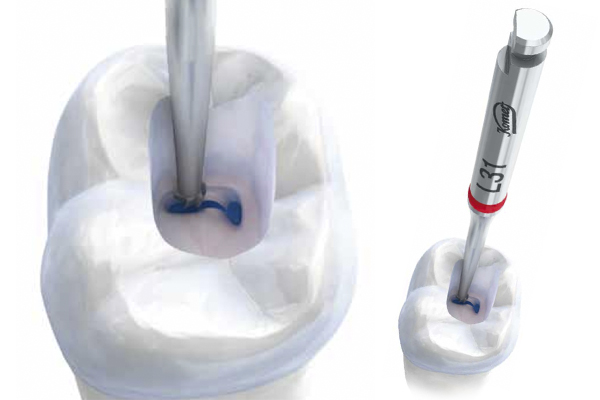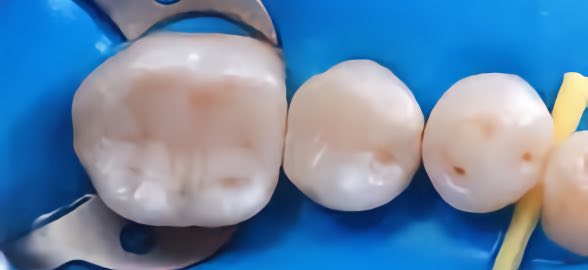The first step towards a successful endodontic operation is opening the pulp chamber and locating the root canals. This step has often been neglected by manufacturers in favor of large advances in conduit instruments with enormous varieties of rotary files with all kinds of geometries, shapes and new NiTi alloys that dominate the market.
The importance of successful root access
Traditionally tungsten ball burs, the well-known Gates-Glidden brand and Endo-Z burs have been used for these types of operations. Dentaltix brings you innovations from the prestigious German brand KOMET, designed to adapt to the demands of modern endodontics and to open the path for rotary files and to allow for the use of microscopes.
A successful and safe root canal operation depends on the creation of a straight path to the root system.
EndoGuard Aperture Drills
The EndoGuard range of drills from KOMET help to achieve the best access to the root canals, thanks to its inactive tip and its excellent cross-sectional capability it allows for the enlargement of the bottom of the pulp chamber while avoiding perforations, guaranteeing visibility and direct access to allow for posterior instrumentation.
Advantages of EndoGuard drills
-
Perfect Cavity Access: The EndoGuard allows for access to the pulp chamber by removing excessive dentin from the side walls while preserving the chamber floor, even in the most difficult situations. It improves visibility and allows for the detection of the root canals. Unobstructed access to the root system minimizes the risk of root canal perforations, conduit steps and file fracture.
- Protection of the Pulp Chamber Floor: Designed with a smooth inactive tip, the EndoGuard preserves the pulp chamber floor, and prevents excessive removal of healthy tissue, which is vitally important in posterior restoration with posts, etc
- No undercuts: Thanks to its conical shape, it avoids the involuntary preparation of angulations, steps and undercuts, thus ensuring that the residue of infected tissue do not remain within the pulp cavity.

Uses of EndoGuard Drills
- Successful and safe root canal treatment is based on the creation of unobstructed access to the root system without undercuts.
- While protruding dentin in the distal part of the tooth reduces the visibility of the root system, thanks to the EndoGuard the visibility of the root canals is excellent in the mesial side.

- Maximum preservation of the pulp chamber walls, and safe operation even in deeper areas

EndoTracer Access Drills
EndoTracer contra-angle instruments have been designed by Komet for root canal detection and cavity floor exposure. Thanks to their multiple sizes and lengths they can be adapted for any type of access cavity. For more complicated cases such as calcified canals and large crowns, the EndoTracer guarantees more conservative and minimally invasive procedures thanks to it's long, thin neck together with good visibility and posterior access for operation of the canals.
The new variety of 34 mm (3mm extra) allows you to work with the best visibility possible with an endodontic microscope as well as in instances of long clinical crowns.

Uses of the EndoTracer:
- Preparation of the endodontic access cavity
- Prepares access to the isthmus
- Conservative opening of the root canal entrances
- Removal of excess dentine in the duct inlet region
- Exposure of obliterated ducts
Advantages of EndoTracer
- Minimally Invasive: Special sizes 004 and 006, ideal for efficient work of isthms and root inputs.
- Size for each case: Available in two lengths of 31 mm and 34 mm (special long clinical crowns), and 6 sizes.
- Sharpened Cut: Sharp toothing removes dentin in the most minimally invasive way with almost no pressure.
- Endodontic Microscope: Thanks to the thin and long neck of 34mm it can be adapted for use with magnifiers and microscopes.

EndoExplorer Root Preparation
Drills for opening the access cavity and access to the root canals, of the latest generation. Equipped with a conical tip , it allows for precise and selective removal on the floor of the access cavity and discovery of the root orifices without sacrificing healthy tissue, ensuring a minimally invasive approach.
Improves the long-term prognosis of endodontically treated teeth and facilitates their subsequent restoration.

Features:
- Fine, conical tip
- Long, slender neck, specially designed for use with dental microscopes
- Provides a direct and clear view of the access cavity
- Toothed and very sharp cutting structure with active cutting tip
- Allows almost pressureless dentine removal
- Precise and controlled work
- Manufactured whole in Tungsten Carbide
- Available for Contra-angle (low speed 2000rpm) and for Turbine (high speed 10000rpm)
Usage Sequence of the EndoExplorer
- Initial formation of the access cavity and exposure of the entrances to the ducts with the EX2 instrument
- Widening of the access cavity with the EX2 instrument by moving it in the direction of the cavity edge, to allow unobstructed access for nickel-titanium instruments and an improved approach to the coronal reference point.

- Exposure of isthmus between ducts using the EX1 instrument

So much for our article on the importance of root access for successful endodontic treatment. We hope that it has been useful, and that the simplification of the advantages provided by each one of the rotating files in each case, will help you to understand them more easily.
If you want to know more about the Komet file system, visit our blog article F360 Endodontic File System Demonstration where we summarize the biomechanical preparation process of the root canals. Or you can consult the Komet product recommendations to carry out each step of the treatment in the post-endodontic treatment, products for each step..





